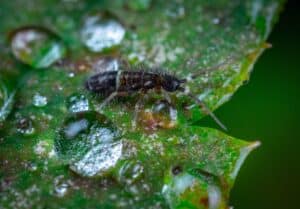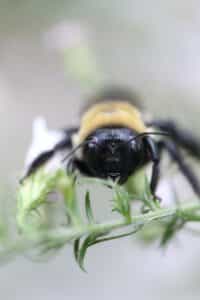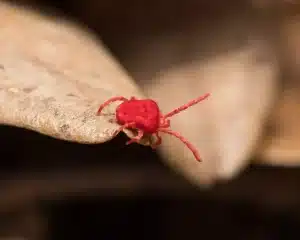3 Common Spring Pests in PA and How to Identify Them

Spring is a beautiful time in Pennsylvania, but it also marks the return of some unwelcome guests – pests! From springtails to clover mites to carpenter bees, these critters can make life miserable for homeowners and their families. That’s why it’s essential for pest control technicians to equip and prepare you for ways to protect and prevent your home and family during this hot season. By understanding their unique characteristics and behaviors, technicians can develop effective strategies for keeping them at bay.
Plus, with some pests posing health risks and others capable of causing structural damage, it’s crucial to address infestations quickly and efficiently. So let’s take a closer look at some of the most common spring pests in Pennsylvania and learn how to keep them from spoiling the season!
Springtails
 Springtails are tiny, wingless insects that get their name from their ability to catapult themselves into the air using a tail-like structure called a furcula. These pests commonly inhabit moist environments such as soil, leaf litter, and damp wood. They have a reputation for reproducing rapidly and can swiftly infest homes and other structures. They exhibit an attraction to moisture and frequently inhabit basements, bathrooms, and kitchens, where they consume organic matter like mold and mildew.
Springtails are tiny, wingless insects that get their name from their ability to catapult themselves into the air using a tail-like structure called a furcula. These pests commonly inhabit moist environments such as soil, leaf litter, and damp wood. They have a reputation for reproducing rapidly and can swiftly infest homes and other structures. They exhibit an attraction to moisture and frequently inhabit basements, bathrooms, and kitchens, where they consume organic matter like mold and mildew.
Signs of a Springtail Infestation:
Signs of a springtail infestation may include seeing small jumping insects in and around the home, particularly in areas with high humidity. Additionally, if you notice small, black, or gray patches on walls, ceilings, or baseboards, this may be a sign of springtail activity. These patches are actually fecal matter from insects. Lastly, if you notice a musty or earthy odor in your home, this could be a sign of springtail activity. The odor is caused by the accumulation of fecal matter and decaying organic matter.
To prevent springtail infestations, homeowners should eliminate moisture sources such as leaky pipes, standing water, and excess humidity. Regularly cleaning and drying out damp areas can also help to reduce their numbers. In severe cases, a pest control professional may need to be called in to apply insecticides and other treatments to eliminate the infestation.
Clover Mites
Clover mites are tiny arachnids that are often mistaken for insects due to their small size and similar appearance. These mites are typically less than 1 millimeter in length and are bright red to reddish-brown in color. They have eight legs and a round body and are commonly found on clover, grass, and other vegetation.
People have introduced these pests from Europe to many other parts of the world, including Philadelphia… unfortunately. Clover mites have spread widely as a result and are now considered a common household pest. Clover mites typically come in large numbers and tend to invade homes in the spring and fall. These mites are attracted to the warmth of buildings and can enter through tiny cracks and gaps around doors, windows, and foundation walls. Once inside, they can be found on walls, curtains, and other surfaces in large numbers.
Signs of a Clover Mite Infestation:
Signs of a clover mite infestation include seeing small red or brown specks on walls, windowsills, and other surfaces. These mites do not bite or sting, but their sheer numbers can be unsettling for homeowners.
In Pennsylvania, the humid summers and frequent rainfalls provide ideal conditions for clover mite populations to explode. Homeowners should be on the lookout for these tiny pests in damp areas of their homes. Especially areas with leaky pipes or standing water are very important to keep an eye on.
Additionally, homeowners can trim back vegetation and keep grassy areas away from the home’s exterior. This can help to reduce the mite population and limit their ability to enter the home.
If an infestation does occur, it’s best to seek the help of a licensed pest control professional who can provide effective treatment options. They may recommend the use of insecticides or other treatments to eliminate the mites and prevent future infestations. Here at PCT, we offer three different routine service packages that will help maintain pest free homes and eliminate your worries. We offer the All Seasons, All Seasons Plus, and All Season Premier. Make sure to check them out, in light of the current season we are in, it is very important to begin taking preventative measures!
Carpenter Bees

Carpenter bees are often mistaken for bumblebees due to their similar appearance, but they can be distinguished by their shiny, hairless abdomen. Unlike bumblebees, carpenter bees are not social insects and do not form colonies. However, they can cause damage to wooden structures including decks, porches, and eaves.
Signs of a Carpenter Bee Infestation:
The signs of a carpenter bee infestation include round holes in wood surfaces, as well as sawdust or wood shavings on the ground or nearby surfaces. In addition, homeowners may notice carpenter bees flying around wooden structures,. Particularly in the spring when they are searching for suitable nesting sites.
Springtails inhabit moist environments such as soil, leaf litter, and damp wood. Their rapid reproductive abilities are well-known, allowing them to quickly infest homes and other structures. They exhibit an attraction to moisture and frequently occupy basements, bathrooms, and kitchens, where they feed on organic matter such as mold and mildew. In addition, filling in any existing carpenter bee holes with wood putty or caulking can help to deter these pests from reusing the same nesting site.
If a carpenter bee infestation is suspected, it’s best to contact a licensed pest control professional. Professional can best assess the extent of the damage and help recommend treatment options.
Key Techniques for Identifying and Monitoring the Spring Pests in PA
To properly identify these pests, technicians should look for key physical characteristics such as size, color, and distinctive markings. They should also be aware of common locations where these pests are found, as this can help to narrow down the search area.
For example, areas with high humidity or moisture often harbor springtails, while sunny sides of buildings tend to attract congregations of clover mites.
Best practices for identifying and monitoring pest activity include conducting regular inspections of homes and outdoor areas. It is also important to keep detailed records of any pest sightings or activity. By staying up-to-date on the latest identification and monitoring techniques, pest control technicians can provide effective pest management solutions to homeowners in Pennsylvania.
Spring Pest Control: How PCT Can Save the Season
Spring pests can not only be a nuisance but also a health concern to homeowners in Pennsylvania. From springtails, to clover mites, and carpenter bees, these pests can cause extensive damage to properties if left untreated. With the proper identification and monitoring techniques, PCT can provide effective pest management solutions to keep these pests at bay. We have been in the business of protecting homes and families for over 45 years. Our motto is simple: protecting homes, health, and families since 1976. We will go above and beyond to take care of our people and our planet!
With proactive pest control measures in place, homeowners can enjoy a pest-free spring season and beyond. Here at PCT, we offer three different routine service packages that will help maintain pest free homes and eliminate your worries: All Seasons, All Seasons Plus, and All Season Premier. If you suspect a pest infestation in your home, contact us today and we would be happy to help!
Save big on all your pest control needs! Get a free pest quote today!
Get a Free Quote"*" indicates required fields


